The NVIDIA GeForce GTX 980 Review: Maxwell Mark 2
by Ryan Smith on September 18, 2014 10:30 PM ESTBioshock Infinite
Bioshock Infinite is Irrational Games’ latest entry in the Bioshock franchise. Though it’s based on Unreal Engine 3 – making it our obligatory UE3 game – Irrational had added a number of effects that make the game rather GPU-intensive on its highest settings. As an added bonus it includes a built-in benchmark composed of several scenes, a rarity for UE3 engine games, so we can easily get a good representation of what Bioshock’s performance is like.
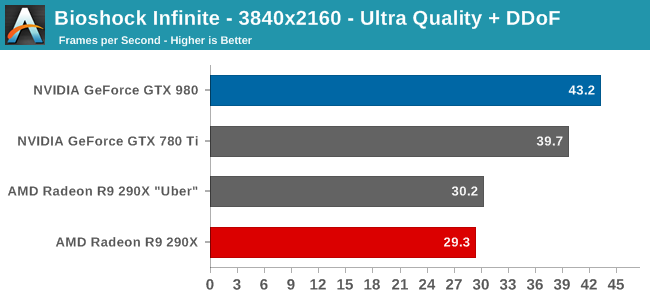
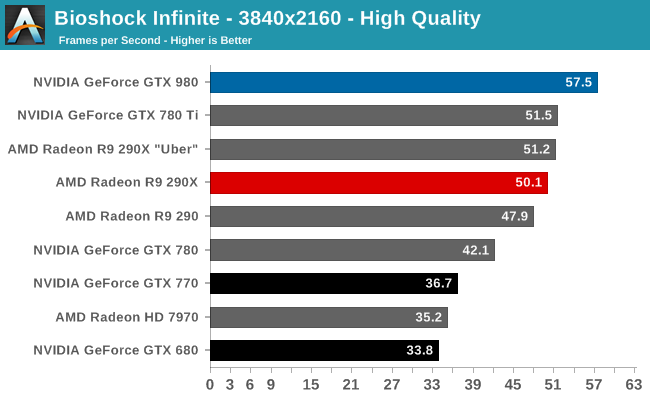
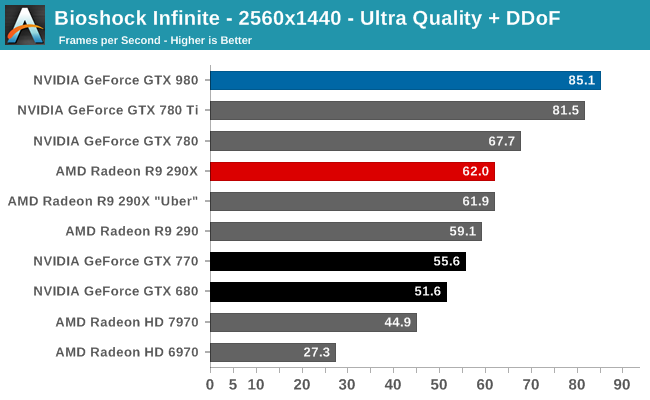
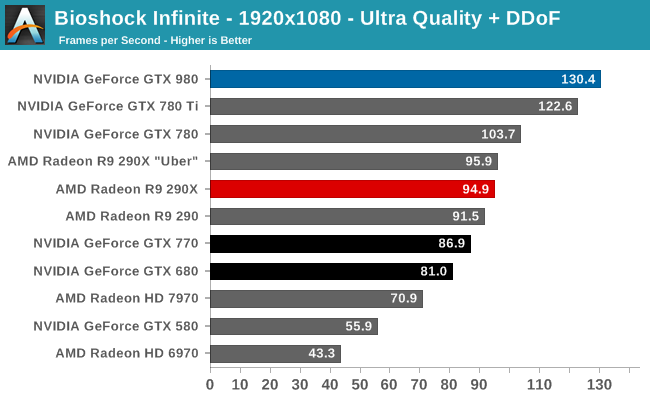
Even with advanced depth of field effects, our highest end video cards are starting to run away with Bioshock: Infinite. That is particularly true for the GTX 980, which in a game that NVIDIA frequently does well in further props up the GTX 980’s advantage. Only at 4K are the R9 290XU and GTX 980 anywhere near close, otherwise at 1440p it’s a 37% performance advantage. GTX 780 Ti on the other hand holds much closer, still falling behind the GTX 980 but only by around 5% at sub-4K resolutions. This does make for a good moment for showcasing the GTX 980’s greater ROP throughput though; as we crank up the resolution to 4K, the 780 Ti falls further behind, especially when we’re at lower quality settings that leave us less shader-bound.
On an absolute basis 120Hz/144Hz gamer should have a blast even with a single GTX 980 at 1080p, while purists will need more performance for 1440p than the 85fps the card can offer. And at 4K the GTX 980 is doing very well for itself, almost cracking 60fps at High quality, and becoming the only card to crack 40fps with Ultra quality.
This will be one of the weaker showings for the GTX 980 over the GTX 680 though; at sub-4K resolutions it’s only a 60-65% performance improvement.


Meanwhile Bioshock is the first of 5 games we can reliably measure with the FCAT tools to check for frame pacing consistency. Bioshock is a bit more erratic than most games in this respect, and while our general rule of thumb for an excellent performance from a single card is 3%, our recording for GTX 980 is a bit higher at 3.5%. On the other hand at 4K it measures in at just 2.3%. So while frame pacing is going to be a bit of a rubber stamping process overall, we can confirm that GTX 980 is delivering a good frame pacing experience in Bioshock.


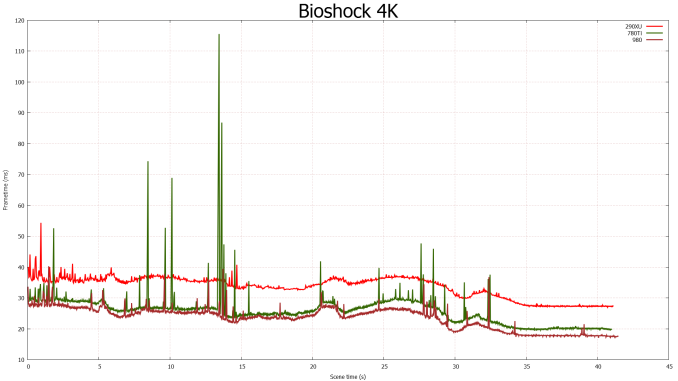








274 Comments
View All Comments
Viewgamer - Friday, September 19, 2014 - link
To Ryan Smith. How can the GTX 980 possibly have a 165W TDP when it actually consumes 8 watts more than the 195W TDP GTX 680 !? please explain ? did Nvidia just play games with the figures to make them look more impressive ?ArmedandDangerous - Friday, September 19, 2014 - link
TDP =/= Power consumption although they are related. TDP is the amount of heat it will output.Carrier - Friday, September 19, 2014 - link
You're right, power consumption and heat output are related. That's because they're one and the same! What else could that electricity be converted to? Light? A massive magnetic field? Mechanical energy? (The fan, slightly, but the transistors aren't going anywhere.)Laststop311 - Friday, September 19, 2014 - link
no they aren't the same. Not all the electricity used is converted to heat. This is where the word EFFICIENCY comes into play. Yes it is related in a way but maxwell is more efficient with the electricity it draws using more of it and losing less of it to converted heat output. It's all in it's design.bernstein - Friday, September 19, 2014 - link
bullshit. since a gpu doesn't do chemical nor mechanical transformations all the energy used is converted to heat (by way of moving electrons around). efficiency in a gpu means how much energy is used for a fixed set of calculations (for example: flops)Senpuu - Friday, September 19, 2014 - link
It's okay to be ignorant, but not ignorant and belligerent.bebimbap - Friday, September 19, 2014 - link
there is "work" being done, as transistors have to "flip" by use of electrons. Even if you don't believe that "input energy =\= output heat" think of it this way100w incandescent bulb produces X amount of useful light
18w florescent bulb also produces X amount of useful light
in this sense the florescent bulb is much more efficient as it uses only 18w to produce the same light as the 100w incandescent. so if we say they produce the same amount of heat, then
100w florescent would produce ~5x the light of a 100w incandescent.
Laststop311 - Saturday, September 20, 2014 - link
ur so smart broGuspaz - Friday, September 19, 2014 - link
The power draw figures in this article are overall system power draw, not GPU power draw. Since the 980 offers significantly more performance than the 680, it's cranking out more frames, which causes the CPU to work harder to keep up. As as result, the CPU power draw increases, counteracting the benefits of lower GPU power draw.Carrier - Friday, September 19, 2014 - link
I don't think that can explain the whole difference. It performs similarly to a 780 Ti in Crysis 3, so the difference in power consumption can only come from the card. The 980 is rated 85W less in TDP but consumes only 68W less at the wall. The discrepancy gets worse when you add losses in the power supply.My guess is the TDP is rated at nominal clock rate, which is cheating a little because the card consistently runs much higher than nominal because of the boost.